You’ve tried countless workouts. You’ve spent hours at the gym. Yet those stubborn areas on the back of your arms just won’t budge.
The truth is that toning your triceps doesn’t require endless gym sessions or expensive equipment. Science shows that targeted, high-intensity bodyweight moves can be more effective than traditional weight training for building lean muscle.
The secret lies in choosing the right exercises. Research confirms that certain bodyweight moves—like diamond push-ups—activate your triceps more than many weighted exercises. When you combine these proven movements into a focused 15-minute routine, you create a powerful muscle-building system that fits into any schedule.
This isn’t another generic list of arm exercises. It’s a scientifically-backed daily routine designed to target your triceps with precision and efficiency. In just 15 minutes, you’ll work through five proven moves that tackle arm flab from every angle.
The Science Behind Arm Flab
Before we jump into the exercises, let’s understand what causes that frustrating “arm flab” and why these specific moves work so well.
Understanding Your Triceps Anatomy
Your triceps muscle makes up about two-thirds of your upper arm mass. This powerful muscle has three distinct heads:
- Long Head: Runs along the back of your arm, most visible when viewed from behind
- Lateral Head: Creates the outer curve of your upper arm
- Medial Head: Lies deeper, providing stability and strength
Here’s what makes your triceps unique: they’re composed of around 67% type II muscle fibers. These fast-twitch fibers respond incredibly well to high-intensity, shorter workouts—exactly what our 15-minute routine provides.
The Fat vs. Muscle Reality
What people call “arm flab” is actually a combination of two things:
- Subcutaneous fat stored under the skin
- Underdeveloped triceps muscle underneath
You can’t spot-reduce fat through exercise alone. But you can build the muscle underneath, which creates that firm, toned appearance as the muscle pushes against the skin. Strong, well-developed triceps naturally create definition and reduce the appearance of loose skin.
Why Bodyweight Training Works So Well
EMG (electromyography) studies measure actual muscle activation during exercise. These studies consistently show that high-tension bodyweight movements can generate more muscle activation than many traditional weighted exercises. Each head of your triceps contributes differently during various shoulder elevations, which is why our routine includes multiple angles of attack.
Your Fitness Level Assessment
Take this quick assessment to determine your starting point:
Core Stability Test:
- Can you hold a plank for 30 seconds?
- Yes = Ready for standard workout
- No = Start with knee modifications
Upper Body Strength Test:
- How many standard push-ups can you do?
- 0-5 = Beginner level
- 6-15 = Intermediate level
- 16+ = Advanced level
Triceps Baseline Test:
- Can you perform 5 triceps dips with good form?
- Yes = Start with straight-leg dips
- No = Begin with bent-knee modifications
Your 5-Move Ultimate Triceps Toning Circuit
1. Diamond Push-Ups
Why it Works: A study sponsored by the American Council on Exercise tested various triceps exercises using EMG technology. The winner? Diamond push-ups generated the highest triceps muscle activation of all moves tested—including weighted exercises. The narrow hand position forces your triceps to do most of the work, making this the king of bodyweight triceps exercises.
Primary Target: All three triceps heads with emphasis on the medial head
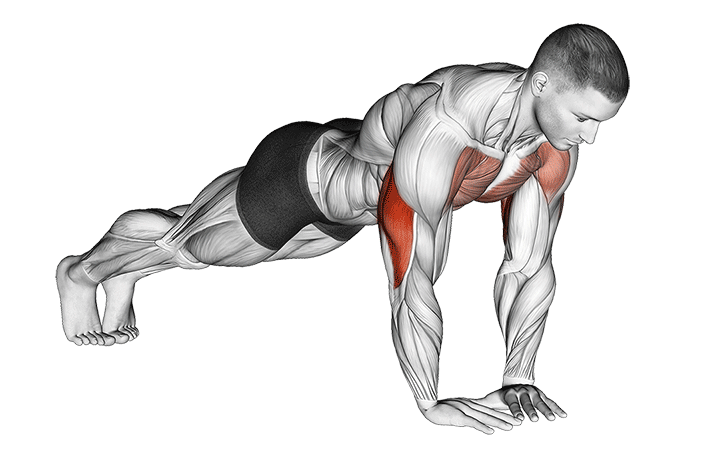
How to Do It:
- Start in a standard push-up position
- Place your hands together under your chest, forming a diamond shape with your thumbs and index fingers
- Keep your body in a straight line from head to heels
- Lower your chest toward your hands, keeping your elbows close to your sides
- Push back up to the starting position
- Focus on squeezing your triceps at the top
Progression Levels:
- Beginner: Knees down, maintain diamond hand position
- Intermediate: Standard form from toes
- Advanced: Elevate feet on chair or step
Common Mistakes to Avoid:
- Hands too far apart (reduces triceps activation)
- Elbows flaring out wide (shifts work to chest)
- Sagging hips (reduces core stability)
2. Triceps Dips (Using a Chair or Step)
Why it Works: Dips isolate your triceps through a full range of motion. This deep stretch at the bottom of the movement hits all three heads of the triceps muscle, creating comprehensive development. The vertical pressing motion also mimics many daily activities, building functional strength.
Primary Target: Long head emphasis due to shoulder extension
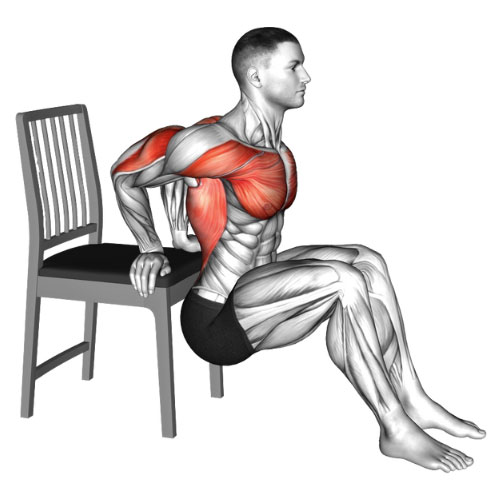
How to Do It:
- Sit on the edge of a sturdy chair or step
- Place your hands on the edge, fingers pointing forward
- Slide your body off the chair, supporting your weight with your arms
- Keep your legs straight and feet planted on the floor
- Lower your body by bending your elbows until they reach about 90 degrees
- Press back up to the starting position
Progression Levels:
- Beginner: Bent knees, feet closer to chair
- Intermediate: Straight legs, feet on ground
- Advanced: Feet elevated on another surface
Troubleshooting:
| Problem | Cause | Solution |
|---|---|---|
| Shoulder pain | Descending too low | Limit range to 90° elbow bend |
| Wrist discomfort | Poor hand position | Adjust grip, use chair with padding |
| Can’t complete reps | Starting too advanced | Use bent-knee modification |
3. Pike Push-Ups
Why it Works: Recent research shows that triceps experience greater growth when trained in overhead or lengthened positions. Pike push-ups place your arms in an overhead pressing position, similar to a shoulder press. This angle maximizes the stretch on your triceps at the bottom of the movement, creating optimal conditions for muscle development.
Primary Target: Lateral head with overhead positioning benefits
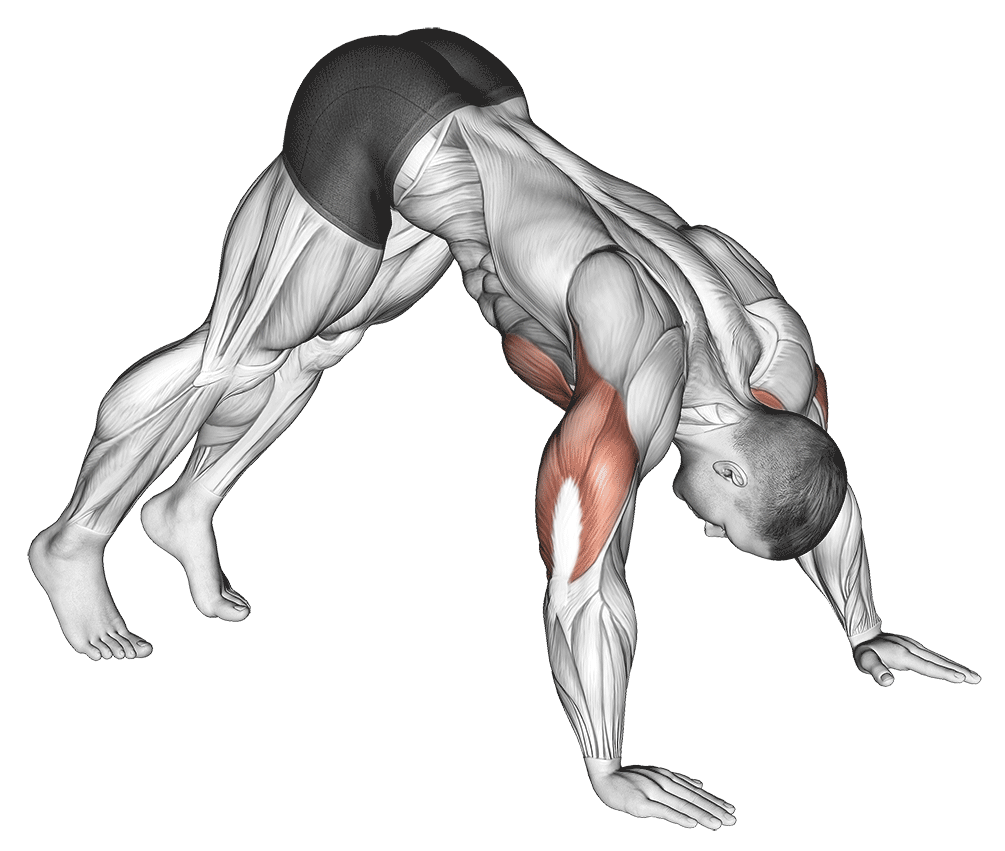
How to Do It:
- Start in a downward dog position, forming an inverted V with your body
- Walk your feet closer to your hands to create a sharper angle
- Keep your legs as straight as possible
- Lower the top of your head toward the ground by bending your elbows
- Press back up, focusing on using your arms to drive the movement
- Keep your core engaged throughout
Progression Levels:
- Beginner: Hands elevated on box or step
- Intermediate: Standard floor version
- Advanced: Feet elevated or single-arm variation
4. Triceps Bodyweight Extensions (Bodyweight Skull Crusher)
Why it Works: This movement replicates the popular “skull crusher” exercise without any equipment. By using a desk, countertop, or chair, you create a unique angle of resistance that isolates your triceps through their full range of motion. The fixed hand position forces your triceps to control the entire movement.
Primary Target: All heads with emphasis on long head due to shoulder position
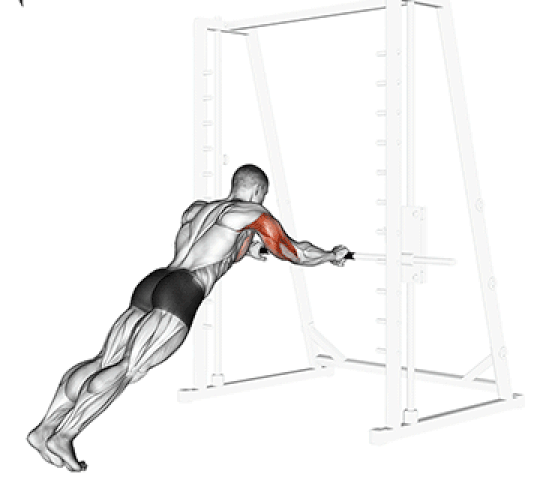
How to Do It:
- Stand arm’s length from a desk, countertop, or back of a sturdy chair
- Place your palms flat on the surface, shoulder-width apart
- Keep your body straight and lean forward at an angle
- Lower your body by bending only at the elbows, keeping them pointing down
- When your head nearly touches the surface, press back to the starting position
- Focus on moving only your forearms—your upper arms should stay still
Progression Levels:
- Beginner: Stand closer to surface (more upright)
- Intermediate: Standard arm’s length distance
- Advanced: Stand farther back (more horizontal)
5. Plank-to-Triceps Push-Up
Why it Works: This compound movement doesn’t just target your triceps—it challenges your entire core and builds functional stability. The transition from forearm plank to high plank forces your triceps to work in a unique way while your core muscles fight to maintain stability. This creates a higher metabolic demand, burning more calories while building strength.
Primary Target: All triceps heads plus core stability
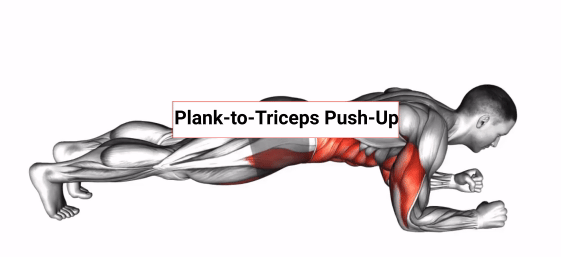
How to Do It:
- Start in a forearm plank position, resting on your forearms
- Keep your body in a straight line from head to heels
- Press up onto your right hand, then your left hand, moving to a high plank
- Lower back down to your forearms, right arm first, then left
- Keep your hips as stable as possible throughout the movement
- Alternate which arm leads the movement with each rep
Progression Levels:
- Beginner: Perform from knees
- Intermediate: Standard from toes
- Advanced: Add resistance band or perform single-arm
Your Complete Workout Plans: Choose Your Level
Quick Start (5 Minutes)
Perfect for busy days or beginners building consistency.
Format: 2 exercises, 2 rounds
- Exercise 1: Diamond Push-ups (30 seconds work, 15 seconds rest)
- Exercise 2: Triceps Dips (30 seconds work, 15 seconds rest)
- Rest 30 seconds between rounds
Standard Workout (15 Minutes)
Our main routine for consistent muscle building.
The Circuit: Perform all 5 exercises in order, one after the other.
The Timing:
- Work Time: 45 seconds per exercise
- Rest Time: 15 seconds between exercises
- Rounds: Complete 3 full circuits
- Rest: 1 minute between rounds
The Math: (45s Work + 15s Rest) × 5 Exercises × 3 Rounds = 15 Minutes
Extended Challenge (25 Minutes)
For those ready to add extra core and shoulder work.
Format: Standard 15-minute routine plus:
- Plank holds: 3 sets of 30 seconds
- Wall handstand holds: 3 sets of 15 seconds
- Mountain climbers: 2 sets of 20 reps
Recovery Day Routine (10 Minutes)
Light movement for active recovery.
Focus: Mobility and gentle activation
- Arm circles: 30 seconds each direction
- Triceps stretches: Hold 30 seconds each arm
- Cat-cow stretches: 1 minute
- Gentle arm swings: 2 minutes
Your Progression Roadmap: From Beginner to Advanced
Beginner Progression Chart (Weeks 1-8)
| Exercise | Week 1-2 | Week 3-4 | Week 5-6 | Week 7-8 |
|---|---|---|---|---|
| Diamond Push-ups | 5-8 reps | 8-12 reps | 12-15 reps | 15-20 reps |
| Triceps Dips | 6-10 reps | 10-15 reps | 15-20 reps | 20-25 reps |
| Pike Push-ups | 3-5 reps | 5-8 reps | 8-12 reps | 12-15 reps |
| Triceps Extensions | 4-7 reps | 7-12 reps | 12-16 reps | 16-20 reps |
| Plank-to-Push-up | 2-4 transitions | 4-6 transitions | 6-8 transitions | 8-12 transitions |
Exercise Difficulty Ratings
| Exercise | Beginner | Intermediate | Advanced | Primary Benefit |
|---|---|---|---|---|
| Diamond Push-ups | Knee version | Standard form | Feet elevated | Maximum triceps activation |
| Triceps Dips | Bent knees | Straight legs | Feet elevated | Full range of motion |
| Pike Push-ups | Hands elevated | Standard | Single arm | Overhead positioning |
| Triceps Extensions | Closer stance | Standard distance | Farther stance | Isolation focus |
| Plank-to-Push-up | From knees | From toes | Added resistance | Functional stability |
Advanced Variations: Ready for More?
Once you can complete the standard workout with perfect form, try these progressions:
Single-Arm Variations:
- Single-arm triceps extensions against wall
- One-arm elevated push-ups
- Alternating single-arm pike push-ups
Plyometric Progressions:
- Explosive diamond push-ups
- Jump transitions in plank-to-push-up
- Clapping push-ups from knees
Time-Under-Tension Techniques:
- 3-second lowering phase on all exercises
- 2-second pause at bottom of movement
- Pulse reps at end of each set
Isometric Holds:
- Hold bottom position of dip for 5-10 seconds
- Maintain low push-up position for 15 seconds
- Static plank hold between transitions
Fuel Your Triceps Growth: Nutrition for Results
Building lean muscle requires the right fuel. Here’s how to support your workouts with smart nutrition choices.
Protein Requirements for Muscle Building
Aim for 0.8-1g of protein per pound of body weight daily. Your muscles need amino acids to repair and grow stronger after each workout.
Best Protein Sources:
- Lean meats (chicken, turkey, lean beef)
- Fish and seafood
- Eggs and egg whites
- Greek yogurt and cottage cheese
- Plant-based options (beans, lentils, quinoa)
Pre-Workout Fuel (30-60 minutes before)
You need easily digestible energy that won’t cause stomach upset.
Good Options:
- Banana with 1 tablespoon almond butter
- Greek yogurt with berries
- Apple slices with string cheese
- Handful of dates with nuts
Post-Workout Recovery (Within 30 minutes)
Your muscles are primed to absorb nutrients for repair and growth.
Ideal Combinations:
- Greek yogurt with berries and granola
- Chocolate milk (3:1 carb to protein ratio)
- Protein smoothie with banana and spinach
- Turkey and avocado wrap
Daily Hydration Guidelines
Proper hydration supports muscle function and recovery. Aim for:
- 8-10 glasses of water daily
- Extra 16-20 oz during workout days
- Monitor urine color (pale yellow is ideal)
What to Expect: Your Results Timeline
Understanding realistic expectations keeps you motivated and consistent.
Week 1-2: Foundation Building
Physical Changes:
- Improved muscle activation
- Less fatigue during exercises
- Better mind-muscle connection
- Slight reduction in muscle soreness
Strength Gains:
- 20-30% increase in reps completed
- Better form and control
- Increased exercise confidence
What You’ll Feel:
- More energy throughout the day
- Improved posture awareness
- Better sleep quality
Week 3-4: Early Improvements
Physical Changes:
- Slight muscle firming
- Better definition when flexed
- Clothes may feel different in shoulder area
- Reduced “jiggle” during movement
Strength Gains:
- 40-50% increase in reps from baseline
- Ability to hold positions longer
- Ready for intermediate modifications
What You’ll Feel:
- Noticeable strength in daily activities
- Confidence boost from progress
- Habit formation taking hold
Week 5-8: Visible Results
Physical Changes:
- Clear muscle tone improvement
- Visible definition even at rest
- Reduced appearance of loose skin
- Overall arm circumference may increase (muscle growth)
Strength Gains:
- 60-80% improvement in reps
- Ready for advanced progressions
- Endurance significantly improved
What You’ll Feel:
- Pride in your transformation
- Clothes fitting better
- Compliments from others
- Strong habit established
Month 3+: Significant Transformation
Physical Changes:
- Dramatic reshaping of arm appearance
- Well-defined triceps heads visible
- Functional strength in daily tasks
- Overall upper body transformation
Strength Gains:
- Ready for advanced variations
- Can perform exercises others find challenging
- May be ready to add resistance
Troubleshooting: Why Your Arms Aren’t Changing
If you’re not seeing the progress you expect, here are the most common issues and solutions.
Common Problems and Solutions
| Problem | Likely Cause | Solution |
|---|---|---|
| No visible changes after 3 weeks | Inconsistent training | Commit to daily 15-minute routine |
| Plateau in strength gains | Not progressing difficulty | Move to next exercise level |
| Joint pain during exercises | Poor form or too advanced | Review form checklist, use modifications |
| Fatigue too quickly | Inadequate recovery | Ensure 7-9 hours sleep, proper nutrition |
| Muscle soreness lasting 48+ hours | Overtraining or poor nutrition | Add rest days, increase protein intake |
Form Errors That Kill Results
Diamond Push-ups:
- ❌ Hands too far apart
- ✅ Thumbs and index fingers touching
Triceps Dips:
- ❌ Going too low (below 90°)
- ✅ Stop when elbows reach 90° bend
Pike Push-ups:
- ❌ Moving head forward instead of straight down
- ✅ Lower top of head toward ground
Triceps Extensions:
- ❌ Moving entire arm instead of just forearm
- ✅ Keep upper arms stationary
Plank-to-Push-up:
- ❌ Rocking hips side to side
- ✅ Keep hips stable and square
Realistic Expectation Check
What This Workout Can Do:
- Build lean muscle mass in your triceps
- Improve muscle tone and definition
- Increase functional strength
- Reduce appearance of loose skin
What This Workout Cannot Do:
- Spot-reduce fat from your arms only
- Create overnight transformations
- Replace proper nutrition for fat loss
- Work without consistency and effort
Progress Tracking: Measure Your Success
Use this template to track your improvements:
Week 1 Baseline Assessment
Strength Test:
- Diamond Push-ups: ___ reps in 45 seconds
- Triceps Dips: ___ reps in 45 seconds
- Pike Push-ups: ___ reps in 45 seconds
- Triceps Extensions: ___ reps in 45 seconds
- Plank-to-Push-up: ___ transitions in 45 seconds
Measurements (Optional):
- Upper arm circumference: ___ inches
- Flexed arm circumference: ___ inches
Weekly Progress Tracker
🏋️ Triceps Progress Tracker
Current Week Progress
Exercise Strength Progress
Today's Workout Entry
Workout History
Set Your Goals
Goal Progress
Data Management
Safety First: Who Should Modify This Workout
While bodyweight exercises are generally safe, certain conditions require modifications or medical clearance.
Consult Your Healthcare Provider If You Have:
- Recent shoulder, elbow, or wrist injuries
- Chronic joint conditions (arthritis, tendinitis)
- Heart conditions or blood pressure concerns
- Any condition that limits physical activity
Pregnancy Modifications
If you’re pregnant, these modifications keep you safe:
- Avoid prone positions after first trimester
- Use incline push-ups instead of floor versions
- Limit range of motion if uncomfortable
- Stop if you experience dizziness or unusual fatigue
Age-Specific Considerations (50+)
- Warm up thoroughly before starting
- Focus more on form than speed
- Allow extra recovery time between sessions
- Consider joint-friendly modifications
- Listen to your body and rest when needed
When to Stop and Seek Help
Stop exercising immediately if you experience:
- Sharp, sudden pain
- Chest pain or difficulty breathing
- Dizziness or lightheadedness
- Nausea or vomiting
- Severe joint discomfort
No Chair? No Problem! Equipment-Free Alternatives
Can’t find a stable chair or step? These alternatives work just as well.
Floor-Based Triceps Dips
- Sit on the floor with knees bent, feet flat
- Place hands behind you, fingers pointing toward feet
- Lift hips off ground
- Lower and raise by bending elbows
- This variation reduces range of motion but maintains triceps focus
Wall-Based Triceps Extensions
- Stand arm’s length from a wall
- Place palms flat against wall at shoulder height
- Perform the same movement pattern as the surface version
- Adjust distance from wall to change difficulty
Outdoor Workout Adaptations
- Use park benches for dips
- Find picnic tables for elevated exercises
- Use playground equipment creatively (always prioritize safety)
- Grass or sand provides cushioning for floor exercises
Take Action: Your 15-Minute Challenge Starts Now
You now have everything you need to transform your arms: a scientifically-backed routine, detailed progressions, troubleshooting guides, and realistic expectations.
Your Next Steps:
- Assess your fitness level using our quick tests
- Choose your starting workout format (Quick Start, Standard, or Modified)
- Set up your tracking system using our progress templates
- Commit to consistency – just 15 minutes daily
- Take a “before” photo for your own motivation
The 2-Week Challenge:
Commit to doing this routine for just 14 days. That’s only 3.5 hours total time investment. After two weeks, assess your progress:
- How do your arms look and feel?
- How much stronger have you gotten?
- How has your confidence changed?
Remember:
- Progress over perfection – some movement beats no movement
- Consistency over intensity – daily practice creates lasting change
- Form over speed – quality reps build quality muscle
- Patience over pressure – your body needs time to adapt and grow
The timer is waiting. Your transformation starts with the first rep of the first exercise.
15-Minute Triceps Toning Timer
Get Ready!
Prepare for your workout
Today's Exercises:
- Diamond Push-ups
- Triceps Dips
- Pike Push-ups
- Triceps Extensions
- Plank-to-Triceps Push-up
FAQs
How long does it take to tone arm flab?
Most people see initial improvements in muscle tone within 2-3 weeks of consistent training. Significant visible changes typically occur by 6-8 weeks. Remember, results depend on consistency, starting fitness level, and overall lifestyle factors.
Can you get rid of arm flab without weights?
Absolutely! Bodyweight exercises can be just as effective as weighted movements for building lean muscle. The key is choosing exercises that create high muscle tension, like the ones in our routine. EMG studies confirm that diamond push-ups activate triceps more than many weighted exercises.
What’s the fastest way to tone flabby arms?
Consistency beats intensity every time. Doing this 15-minute routine daily will produce faster results than longer, less frequent workouts. Combine the exercises with adequate protein intake and overall healthy eating for optimal results.
Do arm exercises really work for women over 40?
Yes! Muscle building capacity doesn’t significantly decline until much later in life. Women over 40 may see slightly slower initial progress but achieve excellent results with consistent training. The key is proper form and gradual progression.
Why can’t I do diamond push-ups?
Diamond push-ups are challenging! Start with the knee modification or try regular push-ups first to build base strength. You can also place your hands slightly wider than diamond position and gradually move them closer together as you get stronger.
How many calories does this workout burn?
This routine typically burns 80-150 calories, depending on your body weight and intensity. However, the real benefit comes from the muscle-building effect, which increases your metabolism for hours after the workout ends.
Can I do this routine every day?
Yes, this routine is designed for daily use. The volume and intensity are appropriate for everyday training. However, listen to your body—if you feel overly fatigued or sore, take a rest day or switch to the recovery routine.
What if I can’t complete the full 15 minutes?
Start where you are! Even 5 minutes of consistent training beats zero minutes. Use the Quick Start routine until you build enough endurance for the full workout. Progress is better than perfection.


